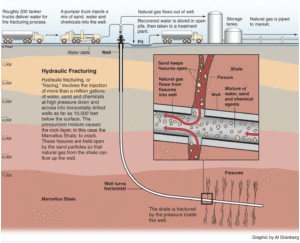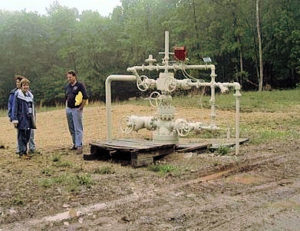Despite the widespread use of the practice, and the risks hydraulic fracturing poses to human health and safe drinking water supplies, the U.S. Environmental Protection Agency (“EPA”) does not regulate the injection of fracturing fluids under the Safe Drinking Water Act.
The oil and gas industry is the only industry in America that is allowed by EPA to inject known hazardous materials — unchecked — directly into or adjacent to underground drinking water supplies.
This exemption from the SDWA has become known as the “Halliburton loophole” because it is widely perceived to have come about as a result of the efforts of Vice President Dick Cheney’s Energy Task Force.
Before taking office, Cheney was CEO of Halliburton — which patented hydraulic fracturing in the 1940s, and remains one of the three largest manufacturers of fracturing fluids. Halliburton staff were actively involved in review of the 2004 EPA report on hydraulic fracturing.
State regulation
Several oil and gas producing states have regulations governing some aspects of hydraulic fracturing, but they rarely, if ever, do they require companies to provide detailed information on types and quantities of chemicals being used, and whether the amount injected underground returns to the surface or remains underground.
Additionally, in most states companies do not have to prove that fractures have stayed within the target formations. Nor do companies have to monitor water quality when there are drinking water formations in close proximity to areas where hydraulic fracturing occurs.
The history of federal regulation
In 1997, the U.S. Court of Appeals for the 11th Circuit (Atlanta) ordered the EPA to regulate hydraulic fracturing under the Safe Drinking Water Act. This decision followed a 1989 CBM fracturing operation in Alabama that landowners say contaminated a residential water well.
In 2000, in response to the 1997 court decision, the EPA initiated a study of the threats to water supplies associated with the fracturing of coal seams for methane production. The primary goal of the study was to assess the potential for fracturing to contaminate underground drinking water supplies.
Meanwhile, in 2001, a special task force on energy policy convened by Vice President Dick Cheney recommended that Congress exempt hydraulic fracturing from the Safe Drinking Water Act.
The EPA completed its study in 2004, finding that fracturing “poses little or no threat” to drinking water. The EPA also concluded that no further study of hydraulic fracturing was necessary.
The 2004 EPA study has been called “scientifically unsound” by EPA whistleblower Weston Wilson. In an October 2004 letter to Colorado’s congressional delegation, Wilson recommended that EPA continue investigating hydraulic fracturing and form a new peer review panel that would be less heavily weighted with members of the regulated industry. In March of 2005, EPA Inspector General Nikki Tinsley found enough evidence of potential mishandling of the EPA hydraulic fracturing study to justify a review of Wilson’s complaints.
The Oil and Gas Accountability Project (OGAP) has conducted a review of the EPA study. As reported in Our Drinking Water at Risk, we found that EPA removed information from earlier drafts that suggested unregulated fracturing poses a threat to human health, and that the Agency did not include information that suggests fracturing fluids may pose a threat to drinking water long after drilling operations are completed.
OGAP’s review of relevant data on hydraulic fracturing suggests that there is insufficient information for EPA to have concluded that hydraulic fracturing does not pose a threat to drinking water.
Efforts to close the Halliburton loophole
In 2005, a national energy bill included the exemption of hydraulic fracturing from the Safe Drinking Water Act. This bill passed, with the exemption, although it left the door open for the EPA to regulate the use of diesel in hydraulic fracturing operations.
Representatives DeGette, Salazar and Hinchey, and Senators Casey and Schumer have introduced legislation to protect drinking water from oil and gas development — including ending hydraulic fracturing’s exemption to the Safe Drinking Water Act.
The Fracking Responsibility and Awareness of Chemicals Act (FRAC Act), would close the Halliburton loophole and require oil and gas companies to disclose the chemicals they use during the fracking process.
Local governments have written resolutions and letters supporting ending the hydraulic fracturing exemption to the Safe Drinking Water Act and requiring public disclosure of hydraulic fracturing chemicals.
For More Information
- Earthworks (and others): Hydraulic fracturing and the FRAC Act – frequently asked questions. Fact sheet.
- Earthworks: The Oil & Gas Industry’s Exclusions and Exemptions to Major Environmental Statutes. White paper.





